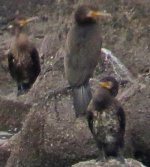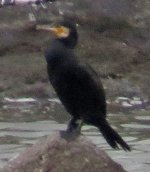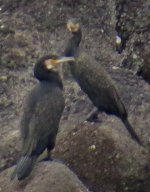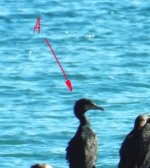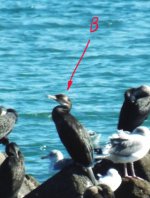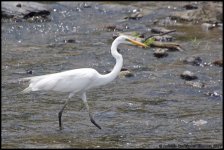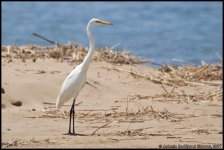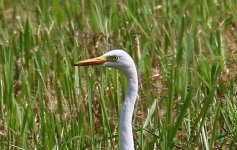So, I guess this leaves us in disagreement over Alex's photo (but not over Antonio's), but hopefully in the mutually respectful position of 'agreeing to disagree'.
Well, yes, we'll have to disagree on this. Looking at Alex's photo, the face on bird A, which he agrees is Great, and on bird B, which he thinks is Temminck's look the same to me apart from the angle of the birds' heads. Neither has the pointy bit which I take to be distinctive of Temminck's. I've blown the head part of this photo up and attached them. But, I can't say it
absolutely isn't Temminck's because of the nature of the photo.
And I tried to post photos of various Great Cormorant heads, some of which (breeding) have rather little yellow. I'm glad if Alex has good shots of Temminck's elsewhere. I just don't think this photo shows them. So, we'll have to disagree, and I fully respect your comments and contribution to this thread, from which I have learned (e.g. by making me look at my old photos and realising I mid-ID'd stuff; and by making me look at various of my books more closely, and decide for myself what criteria I would use to ID these birds definitely).
You may be right and I may be wrong. But, I did try to give detailed reasons for my opinions and back these with extensive visual information, so that people can pick me up on mis-IDs or wrong reasoning, as you have tried to correct me about the rarity of Temminck's. I didn't just say, 'I'm right and you're wrong because I live here and you don't'. I would have been happy if someone who is more knowledgeable than me and more experienced had replied, but they didn't, so I tried to help.
The non-sequitur proposition 'Because it is rare where I live, it must therefore be rare everywhere else' can also be quickly disproved by referring to the sites you yourself provide. 'Kantori Mailing List' is a contributor to eBird, and has posted winter records for Choshi of up to 2000 Japanese Cormorants. There are also winter records of up to 250 at nearby (to Kamakura) Miura.
I apologise again if I came across as gruff on this topic. But I think you are twisting my words a little bit. As I clearly said, it's not rare where I live, it's non-existent, because I live about as far from the sea as you can get in Japan (at least horizontally), and even further from wild sea. And I did agree that the east (Pacific) coast of Honshu may be different.
I am
not denying the existence of 'hot-spots', such as the ones you mention in Choshi and Miura. What I was trying to say was that if you go to a random place on the Japanese coast, even if it's a bit rocky, and even in winter, and see cormorants, they are much more likely to be Great than to be Temminck's. After all, people point out hotspots for a species
precisely because you can't just find them any old place.
But I have searched for Temminck's when I have visited the coast (near or far) in winter, and not found many. And when I reviewed old photos when preparing a reply to this thread, I realised I'd seen even fewer than I thought. We have Great Cormorants at my local pond - some seem to stay over the summer, and in winter there are hundreds. When on trips to the coast, near or far, I have searched for Temminck's and even in winter seen very few.
Having never been there, I don't know Japan at all well...
Well, if you do decide to make a trip (preferably not in summer, over the New Year or at Golden Week), send me a PM, fly to Kansai airport, and I'll treat you to dinner in Nara (and a room if you like). We live right next to all the main sites in the World Heritage area.





